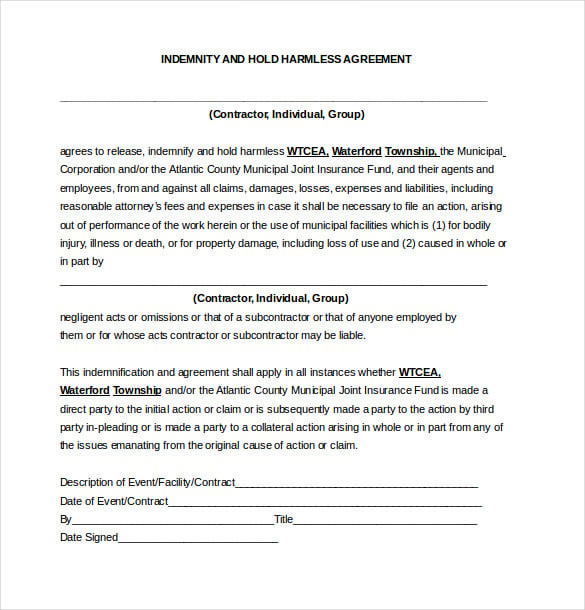
Fill Out Hold Harmless Indemnity In Minutes. Comprehensive-Immediate Use 2) Print, Save, Download 1 Free Today. Secure Cloud Storage. No Installation Required.

Protect Yourself from Any Future Losses by Creating a Free Hold Harmless Indemnity Agreement. Create Liability Release Waivers Stress Free. Do I really need a hold harmless agreement?
What does “hold harmless” mean? Are hold harmless agreements legally binding? A hold harmless clause is a statement in a contract that states that an organization or individual will not be held liable for any injuries or damages caused to the other party. A hold harmless agreement (also known as an indemnity agreement or waiver of liability) is a good idea any time you want to shift risk from one party to another.

You can protect other people from being sued by taking on the liability yourself as well. A Hold Harmless ( Indemnity ) Agreement is used between two parties (such as an employer and employee) to establish protection from liabilities, losses, claims, or damages for one of the parties during their involvement in an activity. An Indemnity Agreement is a legal document that transfers risk from one party , the Promisee , to another party , the Promisor.
The Promisor promises to indemnify or hold the Promisee harmless against future claims, losses or damages related to a particular activity. A simple Indemnity Agreement will identify the following basic elements: 1. Promisor: the name and address of the person or corporation making the promise to indemnify 2. Promisee: the name and address of the person or corporation re. See full list on legaltemplates. All activities come with a certain amount of risk. An Indemnification Agreement allows parties to shift risk based on their needs and protect themselves against future lawsuits or losses.
It acts as a form of insurance and also incentivizes parties to enter into contracts they wouldn’t otherwise enter into. For example, if you wanted to remodel your kitchen, you may be reluctant to hire a contractor to come into your home for fear that if the contractor or one of his employees gets injured in. This agreement allows all parties to a contract to know who will bear the responsibility if something goes wrong and prepare accordingly.
Without it, you may get sued or be responsible for damages that were not your fault. Or you may have no incentive to do your job with reasonable care. Who is the Promisor and Promisee 2. Where are the Promisor and Promisee located 4. When is the effective date of the agreement 5. Why might the Promisor not be obligated to indemnify the Promisee 6. INDEMNIFY AND HOLD HARMLESS AGREEMENT.
Subcontractors typically provide hold harmless agreements to contractors, builders, or other related professionals, insuring against all work being executed by the subcontractor. Three types which exist are (1) hold harmless agreements , (2) exculpatory agreements , and (3) indemnity agreements. Hold Harmless Agreement : An agreement whereby the first party (the indemnitor) agrees to hold a second party (the indemnitee) harmless from tort liability arising out of the indemnitor’s negligent act or omission. This form of a Release Agreement , Indemnity Agreement and Hold Harmless Agreement releases a party from certain specified liabilities. Releases are used to transfer risk from one party to another and protect against the released party or reimburse the released party for damage, injury, or loss.
The inherent meaning of “ hold harmless ” is subject to interpretation. The prevailing interpretation is that “ hold harmless ” and “ indemnify ” are synonymous. However, under the minority view, “ hold harmless ” requires payment of both actual losses and potential liabilities, while “ indemnify ” protects against. Reduce Errors With Our Release Waivers.
Find Free Hold Harmless Agreement.
No comments:
Post a Comment
Note: Only a member of this blog may post a comment.